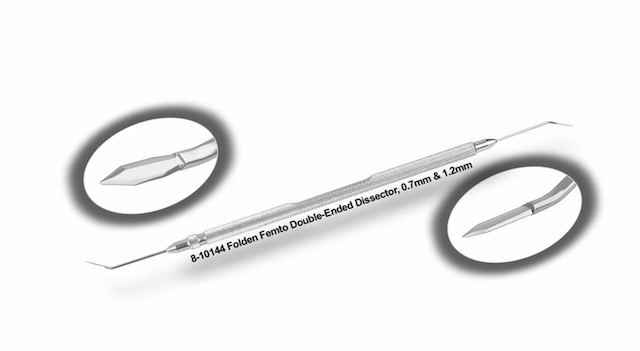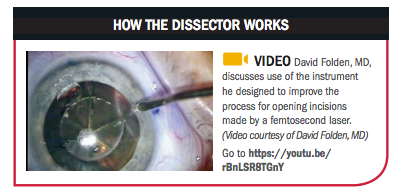Article
Femto-created incision woes solved
A double-ended dissector allows improved opening of all femtosecond laser-created corneal incisions during cataract surgery.
Take-home message: A double-ended dissector allows improved opening of all femtosecond laser-created corneal incisions during cataract surgery.
By Nancy Groves; Reviewed by David Folden, MD
Minneapolis-A new double-ended dissector can open all femtosecond laser-created corneal incisions during cataract surgery, according to its inventor.
The instrument (Folden Femto Double-Ended Dissector, Rhein Medical) combines a semi-blunted leading tip for incision entry with a sharp-edge design. This allows clean separation of inter-wound stromal tissue bridges.
Time to update the endocapsular device toolbox
David Folden, MD, a Minneapolis-area ophthalmologist specializing in cataract and refractive surgery, designed the new instrument to improve the process for opening incisions made by a femtosecond laser.

Though he appreciated the precision and perfect architecture of femtosecond laser-created corneal incisions, the instruments available to open them frustrated him.
Femtosecond laser-created corneal incisions placed more centrally in the clear cornea are relatively easy to open, he said.
“However, incisions placed more peripherally near limbal tissue, corneal arcus, or neovascularization are more incomplete with a greater number of inter-wound stromal tissue bridges, and therefore, are more difficult to open with standard instrumentation,” Dr. Folden said.
Next: Why you should choose this tool
“In addition, a 1-mm paracentesis requires a much finer, more elegant instrument for opening compared with a 2- to 3-mm phaco incision,” he said. “Often, multiple instruments would be necessary to open the various incisions made by the laser, and this disrupted the natural normal flow surgeons are familiar with using manual techniques.”

Many of the instruments were too blunt and rough with the delicate corneal tissue, he noted.
OD-performed surgery unacceptable, dangerous
“They had a tendency to disrupt the femtosecond architecture, increasing corneal edema and surface abrasions,” Dr. Folden said. “This resulted in increased postoperative discomfort and foreign body sensation for the patient.”
Although incisions will improve with advancements in femtosecond laser technology, Dr. Folden recognized that instrumentation for opening incisions also needed to improve. He wanted to have a single instrument that could cleanly and gently open any type of incision with the current femtosecond laser technology.
Here’s how to have a smooth ICD-10 transition
His aim was to design an instrument that would simplify opening incisions, keep the flow of the surgery similar to manual methods, and be able to open all incisions regardless of their size or location in the cornea.
Next: Finding the right combination
It was crucial that both the tip and edge designs be perfect. Dr. Folden designed a tapered, semi-blunted, leading tip sharp enough to score the epithelium, enter a difficult or incomplete incision, and easily intercalate between stromal tissue bridges. The instrument also had to be blunt enough not to penetrate an untreated cornea.
Click for more ophthalmic surgery news
A sharp-edge design evolves just behind the pointed, semi-blunted tip and cleanly separates inter-wound tissue bridges.
“The combination of those two things allows a nice, glided entry into the femtosecond incisions,” Dr. Folden said.
The instrument measures 0.7 mm at one end and 1.2 mm at the other.
According to Dr. Folden, the 1.2-mm end provides easy entry into both standard small clear-corneal incisions and sub-2-mm microincisions, whereas the 0.7-mm end provides adequate clearance for entry into the paracentesis.
Either end of the dissector easily opens arcuate incisions for astigmatism quickly and cleanly without risk of perforation.
David Folden, MD
P: 612/396-9574
Dr. Folden has a financial interest with Rhein Medical regarding this instrument.
Newsletter
Don’t miss out—get Ophthalmology Times updates on the latest clinical advancements and expert interviews, straight to your inbox.





